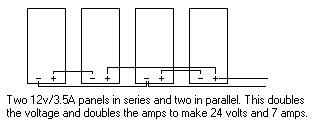2 Answers
Combining Solar Panels into a Solar Array
In most home solar installations the solar panels will be combined into a grouping known as an array. There are several ways of connecting the panels depending upon what you want to accomplish from an electrical point of view. Solar panels can be wired in series or in parallel to increase voltage or amperage respectively. Series wiring refers to connecting the positive terminal of one panel to the negative terminal of another. The resulting outer positive and negative terminals will produce voltage which is the sum of the two panels, but the amperage stays the same as one panel. So two 12 volt/3.5 amp panels wired in series produces 24 volts at 3.5 amps. Four of these wired in series would produce 48 volts at 3.5 amps.
When solar panels are wired for use with a grid-tied systems they are often wired in series in order to produce a fairly high voltage before going to the inverter. The greater the voltage the smaller the wire which is needed to transmit the current, so by wiring the panels in series to increase the voltage it is not necessary to use a large gauge wire. This makes the panels easier to wire and reduces costs since heavy gage wire is very expensive.
Parallel wiring refers to connecting positive terminals to positive terminals and negative to negative. The result is that voltage stays the same, but amperage becomes the sum of the number of panels. So two 12 volt/3.5 amp panels wired in parallel would produce 12 volts at 7 amps. Four panels would produce 12 volts at 14 amps.
When using off-grid systems or grid-tied with battery backup it is common to have all or part of the panels wired in parallel in order to keep the voltage low. This makes it easier to interface to a battery system which is usually 12, 24 or 48 volts. Sometimes a mix of series and parallel wiring is used. In the example below the four panels use a mix of parallel and series wiring.<<<>>>http://energybible.com/solar_energy/solar_panels.html

| 13 years ago. Rating: 2 | |

 larry styles lover
larry styles lover
 lindilou
lindilou
 Best answer!
Best answer!




